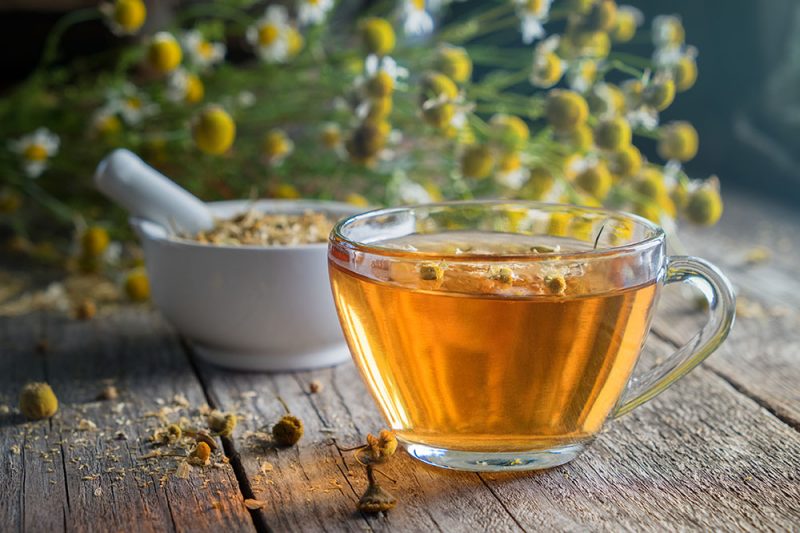
.
Since we are in the “season” of the Heart, we’ve been covering bitter herbs. The bitter flavor cleanses the blood among other things and thus, it is connected to the Heart in the Traditional Chinese Medicine (TCM) Five Phases system.
So far, we have discussed dandelion and California poppy in this bitter flavor series. Our third herb is chamomile. This mildly bitter herb is good to take during summer since it has a cooling energy and has an effect on the TCM Heart. As well, this “common” herb is incredibly versatile, having a variety of uses for health and healing.
There are two widely known chamomiles – one is Matricaria recutita, German chamomile, and the other is Anthemis nobiles, Roman chamomile. Both are used interchangeably, although German chamomile has stronger antispasmodic and anti-inflammatory properties and so is usually preferred. German chamomile has a high concentration of easily assimilable calcium, making it useful for soothing nerves including cramps, spasms (especially gastrointestinal), neuralgia and sciatica.
Many Western nervine relaxants are also described as “hypnotics.” These are herbs whose sedative properties work to still a restless mind and thus induce a state of calm relaxation conducive to sleep. Chamomile is one of these. It treats anxiety, insomnia (especially when it’s hard to fall asleep), nightmares, and nervousness.
Chamomile tea is also wonderful for digestion. It calms the gastric system, soothing nervous stomachs and alleviating indigestion, gas, pain, ulcers, acid reflux, nausea, vomiting, constipation, and other stomach disorders.
As if that’s not enough, chamomile also treats fevers, colds, flu and headaches (particularly when due to indigestion). Further, it brings on menses (especially when delayed from nervousness) and eases menstrual cramps; for this it can be combined with ginger. Externally, a chamomile poultice, bath or herbal wash heals burns, cuts, sore muscles, painful joints, ulcers and rashes. It also makes a good hair rinse for blond hair.
Because it is a safe, mild herb, chamomile is one of the best herbs to use for children’s crying, whining, nervous irritability, nightmares, restlessness, difficulty falling asleep, colic, stomachaches, constipation or fetid diarrhea, nausea, colds, and flu. It’s also invaluable in teething, both for aiding the teeth to come in as well as calming any irritation, restlessness, or fever this process causes. Used in baby’s bath water or as a wash, it clears diaper rash and heals burns, wounds, cuts, and abrasions. Chamomile-infused oil can be combined with mullein or calendula for earaches.
Chamomile, German – Flower Chamomile, Roman – Flower
Matricaria chamomilla and Chamaemelum nobile, formerly known as: Anthemis nobilis
Also named: Matricaria chamomilla Flos, Chamaemelum nobile Flos 
Family: Asteraceae
Energy and flavors: Cool, bitter, spicy
Organs and channels affected: Liver, Stomach, Lung
Chemical constituents: Essential oils, a blue-colored azulene, coumarin, flavonic heterosides, tannic acid
Properties and actions: Calmative, nervine, antispasmodic, anodyne, diaphoretic, emmenagogue, carminative, anti-inflammatory; Calms the Liver
Caution: For those with Asteraceae allergies. Some say that chamomile promotes thyroxine (T4 thyroid hormone), but we have not found any studies to corroborate this. Dosage and preparation: Standard infusion. Tincture (1:2 @75% ABV fresh; 1:5 @50%ABV dry), 10-30 drops TID.
